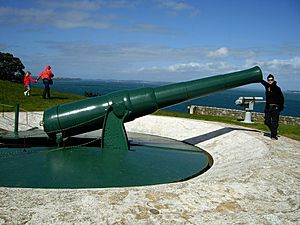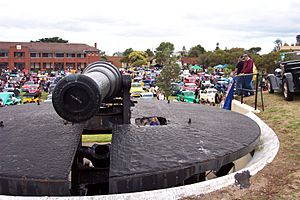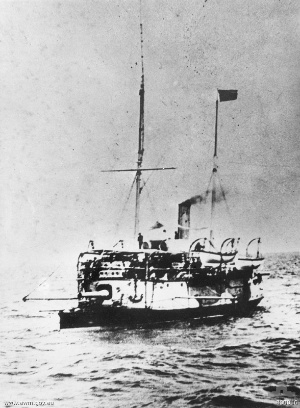BL 8-inch Mk I – VII naval gun facts for kids
Quick facts for kids Ordnance BL 8 inch gun Mks I - VII |
|
|---|---|

|
|
| Type | Naval gun Coast defence gun |
| Place of origin | United Kingdom |
| Service history | |
| In service | 1884 - 190? |
| Used by | Colonial navies of Australia |
| Production history | |
| Designer | Mk I, VI : RGF Mk VII : EOC |
| Manufacturer | Mk I, III, IV : RGF Mk III, IV, VI, VII EOC |
| Unit cost | £6,015 |
| Variants | Mks III, IV, VI, VII, VIIA |
| Specifications | |
| Mass | Mk III & VI : 14 tons Mk IV : 15 tons Mk VII : 12 tons Mk VIIA : 13 tons barrel & breech |
| Barrel length | Mk III : 201 inches (5,105 mm) Mk VII : 204 inches (5,182 mm) Mk IV & VI : 237 inches (6,020 mm) bore |
|
|
|
| Shell | Mks III, IV, VI : 210 pounds (95.25 kg) Mk VII : 180 pounds (81.65 kg) |
| Calibre | 8-inch (203.2 mm) |
| Muzzle velocity | Mk III : 1,953 feet per second (595 m/s) Mk IV & VI : 2,150 feet per second (655 m/s) Mk VII : 2,000 feet per second (610 m/s) |
| Maximum firing range | 8,000 yards (7,300 m) |
The BL 8 inch guns Mark I to Mark VII were large, powerful cannons used by the British military and some other countries a long time ago. These guns were among the first of their kind to be designed with a special way of loading called "rifled breechloader." This meant they were loaded from the back (breech) and had spiral grooves inside the barrel (rifling) to make the shells spin and fly more accurately. They were used both on ships and for defending coasts.
Contents
History of the 8-inch Guns
The very first versions of these guns, called Mark I and Mark II, were mostly test guns. They didn't really get used by the British military. The Mark V version was never even built. Only a few of the other early models were made.
Around 1885, the British Royal Navy decided to stop using 8-inch guns on their main warships. They preferred slightly larger 9.2-inch guns or smaller 7.5-inch guns for their cruisers. However, much later, in 1923, a new rule called the Washington Naval Treaty limited the size of guns on certain warships. This led Britain to create a new 8-inch gun, the Mark VIII, for their heavy cruisers.
Meanwhile, a company called Elswick Ordnance kept making 8-inch guns for other countries, especially Japan. These guns were longer and more powerful.
Mark III Guns
The Mark III guns were not as powerful as some other versions. They were 25 calibres long. One ship that used them was HMS Bellerophon, when it was updated in 1885.
Mark IV Guns
The Mark IV guns were a bit longer, at 30 calibres. They were placed on ships known as the Mersey-class cruisers, which were built around 1885.
Mark VI Guns
The Mark VI guns were also 30 calibres long. They were used on two Indian monitor ships, HMS Abyssinia and HMS Magdala, after they were updated in 1892.
Mark VII Guns: For Ships and Coasts
The Mark VII guns were lighter and less powerful than some other 8-inch guns. They fired a lighter shell, weighing 180 pounds. These guns were important for the navies and coastal defenses of Australia and New Zealand. They were installed because people were worried about Russia expanding its power in the Pacific Ocean during the 1880s.
Mark VII guns were used on several Australian colonial gun vessels. These ships included:
- HMQS Gayundah (from 1884)
- HMCS Protector (from 1884)
- HMVS Albert (from 1884)
- HMVS Victoria (from 1884)
Mark VII Guns for Coast Defense

Many Mark VII guns were set up on special "disappearing mountings" in Australia and New Zealand. These mountings allowed the gun to pop up to fire and then drop back down for protection. This was done during the 1880s when there were fears of a Russian invasion. Luckily, no invasion ever happened, so these guns were rarely, if ever, fired in battle.
Four Mark VII coast defense guns were also placed in Singapore between the 1880s and 1890s. Two were on top of Mount Serapong, and two were at Fort Tanjong Katong.
Ammunition Used
The Mark VII guns fired a lighter shell weighing 180 pounds. Other versions, like the Mark III, IV, and VI, used heavier 210-pound shells.
Where to See Surviving 8-inch Guns
You can still see some of these historic Mark VII guns today:
- A Mark VII gun is located at North Head, in Devonport, New Zealand.
- Another Mark VII is at the top of Mount Victoria, Auckland, New Zealand.
- An unrestored Mark VII disappearing gun can be found at Fort Jervois, Ripapa Island, New Zealand.
- There is a Mark VII gun at Fort Siloso, Sentosa Island, Singapore. You can also find photographs of it online.
- A Mark VII gun is on display at the Royal Artillery Museum in Woolwich, London.
- A Mark VII gun from 1885, on its special hydro-pneumatic mounting, is at Fort Queenscliff, Victoria, Australia.
- A pair of Mark VII guns are located on High Street in Westgarth / Northcote, Victoria, Australia.
- Another pair of Mark VII guns can be seen at Kangaroo Battery, Rosny, Tasmania, Australia.
See also
- List of naval guns
- List of coastal artillery



